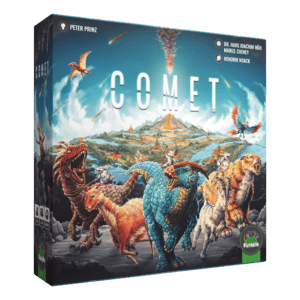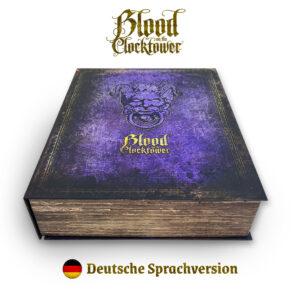We offer a short English summary of some episodes of our German podcast on our blog. You can read one of them here.
A look behind the scenes
In the latest episode of our Funcast, we take a deep dive into the fascinating world of board game development. Together with Maikel from the editorial team, Swantje takes us through the exciting journey from the initial idea to the finished board game that ends up on your table. Sounds easy, doesn’t it? Well, it’s not. There are countless steps between the idea and your first game – and everything has to go right at every step.
The journey starts
The journey of a game begins with a vision and an idea that often takes years to mature before it is brought to a publisher. Maikel explains that very few authors develop games full-time; for most, it’s a side project. Nevertheless, there is a lot of work and, above all, passion behind every game idea.
The secret of success
Have you ever wondered how we evaluate game ideas and prototypes? Maikel finally shares with us the “secret” behind successful proposals. To be more precise, there are 3 rather complex secrets that are difficult to master.
The game should have at least two of the following three key elements when we play it for the first time. We make it our mission to add what is missing and perfect what is already there.
A game idea needs:
Something new and fresh! – Something new and innovative
Values that matter! – Sophisticated balancing
Tell me a story! – A compelling story
Innovation: Something new & spicy
The first pillar of success is innovation. Maikel explains that this can mean either inventing a completely new game mechanic that doesn’t exist yet, or combining familiar mechanics in a fresh, unexpected way. These innovations are key to giving players new experiences and challenging them in ways they don’t see coming. A game that manages to reinvent the familiar or make the unfamiliar accessible has already cleared the first hurdle to success.
Balancing: Values that matter
The second pillar revolves around balancing – a core element of any board game. Sophisticated balancing ensures a smooth, intuitive gaming experience. Maikel emphasizes how important it is that the different game mechanics work together harmoniously, much like the gears of a clock. Every aspect of the game, from card values to movement rules, must have a clear function and contribute to the overall experience. A well-designed game feels rewarding and complete to the player – each component has its place and serves a purpose.
Narrative: Tell me a story
The third and perhaps most immersive pillar is narrative. A game that tells a story or brings to life a world in which players can become immersed provides an immersive experience that extends far beyond the physical game board. Maikel explains how a game’s thematic design adds deeper meaning to its mechanics and helps players remember rules by intuitively guiding them through the story. A strong, compelling narrative can make a game memorable and is often the key to engaging players.
This insight is a good starting point for anyone who wants to take a look at the world of game development, or even take their first (or second) steps.By taking these principles to heart, young authors and developers can create games that not only entertain, but also inspire and are memorable.
The role of the publisher – from concept to reality
Once an idea reaches Funtails, a new chapter of the game idea begins. The vision of the game is sharpened, the target audience is defined, and the artistic process begins. The publisher takes on the task of refining the mechanics and preparing the game for production. This process includes not only art and design, but also fine-tuning the game rules and playtesting to ensure that the game is both challenging and entertaining.
Our motto here: All 3 pillars must not only be present, but must be optimized and combined to complement each other. The art is in blending the elements to create a cohesive, engaging and ultimately fun gaming experience. The Funtails editorial team works closely with the authors.
The development phase – from vision to production
When a game is good enough to be published, it is time to think about how it will look and be marketed. What should the finished game look like, what emotions and feelings should you have when you look at the finished product?
Creative Processes
Different sketches and art styles are tried out. In a “Feed the Kraken” game, for example, our artist Hendrik tries to put himself in the role of a pirate using external aids such as music, podcasts and reports, and to let these emotions flow into the game through his illustrations.
Target audience definition and marketing
At the same time, the process of creating awareness for your product begins. The first step is to define who the game is for. In other words, the question of the target audience. It is helpful to visualize who will be sitting at the table playing the game. Then you need to create a project profile for the game. This should include the technical details of the game (number of players, playing time, game material, etc.) and a short summary of what the core idea of the game should be. Maikel compares the fact sheet to a movie poster. When you look at it, it should be clear what it’s about and who it’s for.
And then it’s about making people aware that there’s a new game. Swantje’s job is to look for specific places where the target group for the game moves.
The importance of haptics and gaming experience
Since a board game at Funtails is designed to end up as a physical object on your table, it is important to optimize the prototype so that it feels good to play on a table. Prototypes are usually designed for functionality, and this needs to be maintained while making them more accessible and attractive. This includes questions such as what game materials are needed, what players need and can hold in their hands, and most importantly, how to make the game flow clearly. Because one thing is important: haptics, like many other things, contribute significantly to immersion.
The role of our “extended family”
Your feedback from the community also influences how our games end up looking. That’s one of the reasons we share our art and get your input early in the design process. So please keep it up. Because at the end of the day, it doesn’t do anybody any good if we release a game that nobody likes.
End of the development phase
Now everything is put together. Our graphics are combined with the rules and material suggestions, and a prototype is designed. It is important for us to consult with the game authors and involve them in the process. The user interface is created during this phase. We clarify what information needs to be conveyed at what points in the game, and to what extent we can illustrate processes through language or graphics. It is important to be fast, creative, and adaptable at this stage. A first prototype does not have to be graphically perfect or win an art award. Simple symbols and a program like PowerPoint or Paint are absolutely sufficient for the first prototype.
The Production
We are now at the point where we know what elements we want our game to have. The next step is to specify those elements in detail. This means that we determine what shape and type of cards we want to use, how big and thick a possible game board should be, etc. This results in a specification sheet that lists all the components of the game and their material properties. The sheet is sent to the production company and then it is a matter of determining the production costs and reducing them as much as possible without neglecting the quality. There are a few tricks to reduce costs. For example, one way is to make everything a die-cut size. A die-cut sheet is a square shape that can hold as many of the game’s shapes as possible, and is then punched out by a machine. It can happen that you end up with more material in a die-cut sheet than the game actually needs, because you want to use the space effectively. The reason for this is that it is cheaper to produce the desired material in the available space on large die-cuts with other parts than to create a new, smaller die-cut to produce the exact amount of material needed.
The End
At the end of the process there are things like barcodes on the packaging, final runs through the instructions, and of course playing the game with test subjects who don’t know the game yet. If all of these steps go to our satisfaction, we put the order into production and the game is produced in larger quantities. But even then, it takes quite a while before the game lands on your table.
We’ll explain why in another podcast. 😉



